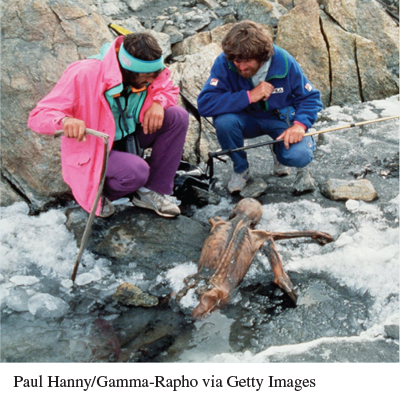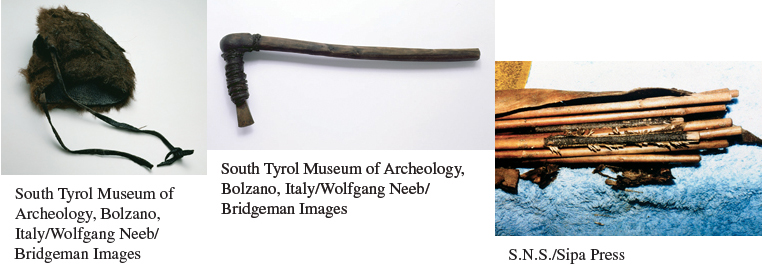A History of Western Society: Printed Page 10
Chapter Chronology
Living in the Past
Page 10

Paul Hanny/Gamma-Rapho via Getty Images;
O n September 19, 1991, two German vacationers climbing in the Italian Alps came upon a corpse lying face-down and covered in ice. Scientists determined that the Iceman, as the corpse is generally known, died 5,300 years ago. He was between twenty-five and thirty-five years old at the time of his death, and he stood about five feet two inches tall. An autopsy revealed much about the man and his culture. The bluish tinge of his teeth showed a diet of milled grain, which proves that he came from an environment where crops were grown. The Iceman hunted as well as farmed: he was found with a bow and arrows and shoes of straw, and he wore a furry cap and a robe of animal skins that had been stitched together with thread made from grass.
The equipment discovered with the Iceman demonstrates that his people mastered several technologies. He carried a hefty copper ax, made by someone with a knowledge of metallurgy. In his quiver were numerous wooden arrow shafts and two finished arrows. The arrows had sharpened flint heads and feathers attached to the ends of the shafts with resin-like glue. Apparently the people of his culture knew the value of feathers to direct the arrows, and thus had mastered the basics of ballistics. His bow was made of yew, a relatively rare wood in central Europe that is among the best for archers.
Yet a mystery still surrounds the Iceman. When his body was first discovered, scholars assumed that he was a hapless traveler overtaken in a fierce snowstorm. But the autopsy found an arrowhead lodged under his left shoulder. The Iceman was not alone on his last day. Someone was with him, and that someone had shot him from below and behind. The Iceman is the victim in the first murder mystery of Western civilization, and the case will never be solved.

The artifacts found with the body tell scientists much about how the Iceman lived. The Iceman’s cap, made of bearskin pieces stitched together with sinew, was worn with the fur on the outside. He also had a coat made out of domestic goatskin, in which light and dark stripes alternated in a striking pattern.
S.N.S./Sipa Press;
- What does the autopsy of the corpse indicate about the society in which the Iceman lived?
- How do the objects found with the Iceman support the generalizations about Neolithic society in this chapter?

